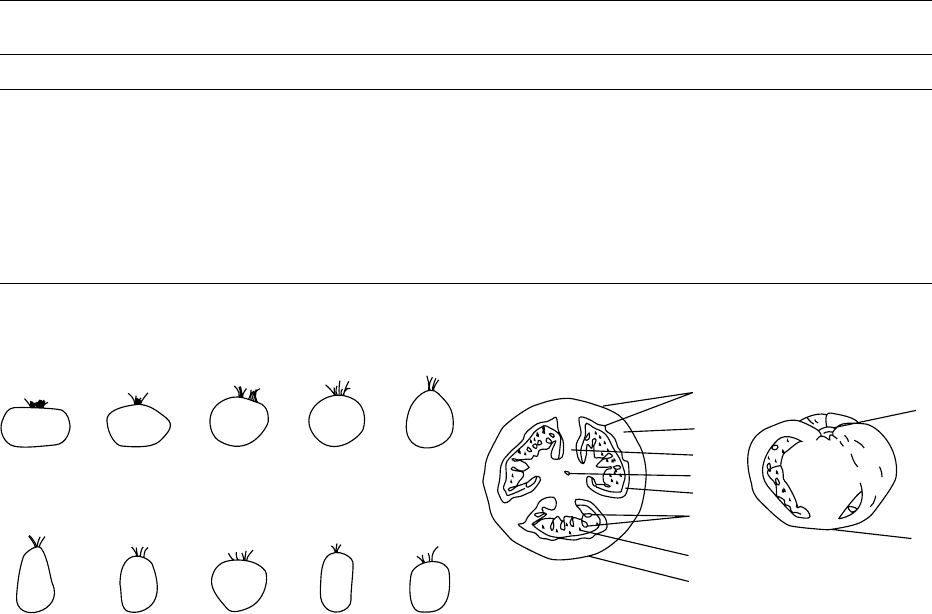Caballero B. (ed.) Encyclopaedia of Food Science, Food Technology and Nutrition. Ten-Volume Set
Подождите немного. Документ загружается.


inhibition of wound healing, increasing the reducing
sugar content, and the problem of toxic residues.
TCNB, CIPC, and IPC treatments are to be coupled
with cold storage, as they are ineffective at tropical
ambient temperatures (> 20
C). The sodium salt of
NAA (1000 p.p.m.) is an effective and economical
postharvest sprout-retardant for storing potatoes
under tropical ambient conditions (Table 9).
0028 Several naturally occurring volatile and aromatic
compounds have proved to be potent sprout inhibi-
tors, but their acceptability for commercial applica-
tion needs further investigation. Ware potatoes (those
potatoes intended for human consumption in contrast
to seed potatoes) can be kept sprout-free for a long
time by irradiation, but its economic feasibility
remains to be ascertained. Irradiated tubers need to
be stored below 20
C, and irradiation often lead
to increased Fusarium attack and discoloration after
cooking. Controlled-atmosphere (CA) storage of
potatoes with as low as 5% carbon-dioxide concen-
tration causes black heart and low oxygen concen-
trations inhibit wound healing; therefore CA storage
appears not to be beneficial. Sprout inhibition beyond
3 months at tropical temperatures (22–35
C) is pos-
sible by periodical vapor heat treatment at 60
C, RH
95% for 60 min (Table 9). This method is superior to
manual desprouting, and avoids the use of toxic
chemicals. Hot-water dip treatment at 57.5
C for
20 or 30 min prior to storage at 18
C enhances
storability, by inhibiting sprouting and spoilage by
Fusarium and Erwinia.(See Irradiation of Foods:
Applications.)
0029 Evaporative cooling systems can be used effect-
ively in tropical conditions to store potatoes. The
containers needed for this storage can be fabricated
locally using brick, sand, bamboo, and metal sheets;
it is a cheaper method of storing potatoes, with re-
duced water loss, at farm level (Table 10). These
containers maintain a high RH (85–95%) in the
atmosphere and the tuber temperature, which is
close to the wet bulb temperature, is the lowest
possible for evaporative cooling. Seed potatoes are
often exposed to natural or artificial light during
storage, as light retards physiological aging, inhibits
sprout growth, and increases resistance to fungal
infections. On the other hand, exposure of ware
potatoes to light should be avoided, as it leads to
the formation of the toxic a-solanine and green
pigment, chlorophyl; the market value of green
potatoes is also low.
0030Avoiding damage to potatoes and dry, cool storage
are necessary to prevent bacterial and fungal attack.
Benzimidazole compounds are used to combat fungal
diseases. Efficient ventilation in any store is necessary
to eliminate excess moisture, which otherwise may
enhance rotting. (See Fungicides; Spoilage: Bacterial
Spoilage.)
See also: Acids: Natural Acids and Acidulants; Ascorbic
Acid: Physiology; Carbohydrates: Classification and
Properties; Requirements and Dietary Importance;
Carotenoids: Occurrence, Properties, and
Determination; Dietary Fiber: Physiological Effects;
Energy: Measurement of Food Energy; Enzymes:
Functions and Characteristics; Fungicides; Protein:
Chemistry; Requirements; Spoilage: Bacterial Spoilage;
Starch: Structure, Properties, and Determination;
Sources and Processing; Storage Stability: Mechanisms
of Degradation
tbl0009 Table 9 Sprout yield in naphthalene acetic acid (NAA) and vapor heat (VH)-treated tubers at the end of 3 months of storage
Storage temperature (
C) Sprout weight (fresh ^ g per100 tubers)
Control NAA-treated Control VH-treated
2 + 1 17.2 6.2
10 + 1 13.9 4.8
25 + 5 26.0 2.5 58.7 10.1
Adapted from Rama MV and Narasimham P (1985) Studies on the effect of various post-harvest treatments for controlling shriveling, sprouting and spoilage of
potatoes during storage. PhD thesis. India: University of Mysore.
tbl0010 Table 10 Physiological loss in weight (PLW), sprouting, and spoilage of potatoes during evaporative cooling storage for 30 days
Parameter Ambient storage (25^35
C) Evaporative cooling storage
Untreated NAA-treated Untreated NAA-treated
PLW (%) 2.6 2.4 1.1 0.9
Fresh sprout weight (g per 100 tubers) 86.1 21.6 70.1 17.1
Spoiled tubers (%) 4.5 0.0 0.0 0.0
Adapted from Rama MV and Narasimham P (1989) Studies on the effect of various post-harvest treatments for controlling shrveling, sprouting and spoilage of
potatoes during storage. PhD thesis. India: University of Mysore.
POTATOES AND RELATED CROPS/The Root Crop and its Uses 4665

Further Reading
Anonymous (1984) A Potato Store Run on Passive Evap-
orative Cooling. Technical bulletin no. 11, pp. 1–14.
Simla, India: Central Potato Research Institute.
Davis HV (1996) Recent developments in our knowledge
of potato transgenic biology. Potato Research 39: 411–427.
Harris PM (1978) The Potato Crop. London: Chapman and
Hall.
Jadhav SJ and Kadam SS (1998) In: Salunkhe DK and
Kadam SS (eds) Handbook of Vegetable Science and
Technology: Production, Composition, Storage and Pro-
cessing, pp. 11–69. New York: Marcel Dekker.
Pushkarnath (1976) Potato in Sub-Tropics. New Delhi:
Orient Longman.
Rama MV (1985) Studies on the effect of various post-
harvest treatments for controlling shriveling, sprouting
and spoilage of potatoes during storage. PhD thesis.
India: University of Mysore.
Rama MV and Narasimham P (1986) Heat treatments for
the control of sprouting of potatoes during storage.
Annals of Applied Biology 108: 597–603.
Rama MV and Narasimham P (1989) Control of potato
(Solanum tuberosum L. cv Kufri Jyoti) sprouting by
sodium naphthyl acetate during ambient storage. Jour-
nal of Food Science and Technology 26(2): 83–96.
Rama MV and Narasimham P (1991) Evaporative cooling
of potatoes in small naturally ventilated chambers. Jour-
nal of Food Science and Techniology 28(3): 145–148.
Rastovski A, Van Es A, Van Der Zaag DE et al. (1987)
Storage of Potatoes. Post Harvest Behaviour, Store
Design, Storage Practice, Handling. Wageningen, The
Netherlands: Center for Agricultural Publishing and
Documentation.
Rich AE (1983) Potato Diseases. New York: Academic Press.
Rodriguez De Sotillo D, Hadley M and Wolf-Hall C (1998)
Potato peel extract: a nonmutagenic antioxidant with
potential antimicrobial activity. Journal of Food Science
63(5): 907–909.
Shashirekha MN (1988) Studies on the extension of storage
life of seed potato tubers stored under different tempera-
ture conditions. PhD thesis. India: University of Mysore.
Singh G, Kapoor IPS and Kumar Pandey S (1997) Studies on
essential oils VII. Natural sprout inhibitors for potatoes.
Pesticide Research Journal 9(1): 121–124.
Smith O (1977) Potatoes, Production, Storing, Processing.
Westport, Connecticut: AVI Publishing.
Upadhya MD (1994) True potato seed; propagule for
potato production for the 21st century. In: Shekhawat
GS, Khurana P, Pandey SK and Chandla VK (eds)
Potato: Present and Future, pp. 15–22. Shimla, India:
Indian Potato Association.
Van Der Zaag DE (1990) Recent trends in development,
production and utilization of potato crop in the world.
Asian Potato Journal 1: 1–11.
Woolfe JA (1987) The Potato in the Human Diet.
Cambridge: Cambridge University Press.
Yamaguchi M (1983) World Vegetables: Principles,
Production and Nutritive Value, p. 415. Westport,
Connecticut: AVI Publishing.
Fruits of the Solanaceae
M V Rama and P Narasimham, Formerly of Central
Food Technological Research Institute, Mysore, India
Copyright 2003, Elsevier Science Ltd. All Rights Reserved.
Background
0001The family Solanaceae includes about 75 genera and
2000 species of herbs, shrubs, and small trees distrib-
uted in the tropical and temperate regions of the
world. Important vegetable crops such as tomato,
brinjal, pepper, tree tomato, and husk tomato are
included in this family. Potato and tobacco are also
from this family. This article reviews the geographical
distribution, morphology, anatomy, chemical com-
position, nutritive value, and uses of some solan-
aceous fruits.
Geographical Distribution, Morphology,
and Anatomy
0002The important fruits of the family solanaceae are
shown in Table 1. Tomato (Lycopersicon esculentum)
is the most popular and widely cultivated vegetable
and has been consumed by the inhabitants of Central
and South America since prehistoric times. It is con-
sidered to be a native of the Peruvian and Mexican
regions. It is an indispensable fruit today, grown all
over the world (outdoors in temperate regions and in
green houses in the colder regions), and constitutes
about 15% of the world total vegetable production
(Table 2). World production of tomato for processing
is over 20 million tonnes, and in the USA, it ranks
second to potato in dollar value, among all the other
vegetables grown. Major tomato-producing countries
tbl0001Table 1 Some important solanaceous fruits
Scientific name Common name
Lycopersicon esculentum Tomato
L. pimpinellifolium Redcurrant or grape tomato
Solanum melongena Eggplant, brinjal, berenjana,
aubergine, guinea squash
S. macrocarpon African eggplant
S. nigrum Garden huckleberry, wonderberry
S. muricatum Pepino, melon pear
S. quitoense Naranjillo, lulo
S. gilo Jilo
Capsicum annuam Bell pepper, sweet pepper
C. frutescens Pimiento, chili, aji,
hot pepper, bird chili
Physalis peruviana Cape gooseberry, uchida
P. ixocarpa Tomatillo, ground cherry
P. purinosa Husk tomato
Cyphomandra betacea Tree tomato, tamarillo
4666 POTATOES AND RELATED CROPS/Fruits of the Solanaceae

are China, USA, Spain, Italy, Turkey, and Russia. The
fruit is normally round, lobed or pear-shaped, and the
diameter ranges from 1 to 12cm. New cultivars
with differently shaped fruits have been developed
to suit mechanical harvesting and handling systems
(Figure 1). It is a two- to many-loculed berry with a
fleshy placenta and many small, kidney-shaped seeds,
covered with short, stiff hairs and a jelly-like paren-
chyma (Figure 2). The tough skin or pericarp thick-
ness varies with the cultivar.
000 3 The genus Lycopersicon includes red-fruited edible
species with carotenoid pigmentation (subgenus
Eulycopersicon), and green-fruited species with
anthocyanin pigmentation (subgenus Eriopersicon).
Lycopersicon esculentum and L. pimpinellifolium
are red-fruited cultivars, while L. pissisi, L. peruvia-
num, L. hirsutum, L. glandulosum, and L. cheesma-
nii are green-fruited. Varieties evolved on pure-line
selection, hybridization, and genetic engineering
techniques for market and processing needs are
also cultivated in many countries. The Flavr-savr
TM
is currently a genetically engineered approved
tomato variety in the US market. Cultivars suited
for home, market, shipping, and processing are listed
in Table 3.
0004The edible Physalis species are grown widely in the
warmer parts of the world. The fruit of Physalis
purinosa (husk tomato) is round, yellowish, and
acidic-sweet. Physalis peruviana (cape gooseberry) is
a native of the Andes, and grows from Venezuela to
Chile; the fruit is a spherical or ellipsoidal, smooth
berry, measuring about 4cm long and 3 cm wide.
The skin color is greenish yellow. Physalis ixocarpa
(tomatillo or ground cherry) is of Mexican origin; the
fruit is a round, green or purplish berry, with a high
ascorbic acid content.
0005Cyphomandra betacea (tree tomato or tamarillo) is
a native of Peru and is also grown in India, Sri Lanka,
and New Zealand. The fruit is greenish or purple in
the early stages and turns reddish at maturity. It has a
musky acid taste and tomato-like flavor. The fruit
rind is rough with a disagreeable flavor. Several
species in the genus Solanum are prominent vegetable
crops. Solanum melongena (eggplant or aubergine) is
a popular and staple vegetable crop in Asia, account-
ing for 92% of the total world production; in Africa
abcde
fghij
fig00 01 Figure 1 Shapesoftomatocultivars.a,flat;b,oblate;c,square
round;d,round;e,pear;f,elongatedpear;g,egg;h,oxheart;
i,blockyelongated;j,blockyround.AdaptedfromGouldWA
(1992)TomatoProduction,ProcessingandTechnology,3rdedn.Bal-
timore,MD:CTI.
1
1
2
2
3
7
4
5
6
8
(a)(b)
fig0002Figure 2 Structureofthetomatofruit:(a)transversesection;
(b)longitudinalsection.(a)1,pericarp;2,outerwall;3,radial
wall;4,locule;5,seeds;6,gel;7,axilefleshycore;8,skin.(b)1,
stemscar;2,blossomendscar.
tbl00 02 Table 2 Worldproductionofmajorsolanaceousfruits(1000tonnes)
RegionsTomatoEggplantCapsicum
World 91 663 21 165 18 024
Africa 10 799 799 2 078
Asia 41 246 19 543 10 715
Europe 19 789 709 2 705
North Central America 13 423 106 2 191
South America 5 990 59 301
Oceania 416 33
Developing countries 56 930 19 852 14 323
Developed countries 34 733 1 313 3 701
Source:FoodandAgriculturalOrganizationStatisticalDatabase–Provisional1999ProductionandProductionIndicesDatawww.fao.org
World production of vegetable þmelon ¼622 428 1000 tonnes.
POTATOES AND RELATED CROPS/Fruits of the Solanaceae 4667

and Europe, its production is 3.7 and 3.3%, respect-
ively (Table 2). The leading country of its cultivation
is China, followed by India, Turkey, Japan, Indonesia,
and Philippines. It is an extensively grown perennial
crop in the tropics and an annual in the temperate
zones. The fruit can be round, globose, long, or pear-
shaped. Most cultivars have purple to blackish skin,
while some have a white–green or mottled green skin,
with white flesh; in the white–green types, the mature
fruit has yellow skin. There are regional preferences
for the color and shape of the fruit; purple, large,
more or less round fruits are preferred in North Amer-
ica. Wild eggplants with spiny and bitter fruits are
found in India; of the several improved Indian culti-
vars, black beauty, long black, round purple, Pusa
purple long, Pusa purple round, Pusa purple cluster,
long purple and hybrids such as Vijay, S-1, S-4, S-5,
and S-8 are popular. Solanum melongena has three
main varieties; see Table 4.
0006 The African eggplant (S. macrocarpon) is a peren-
nial crop grown in the Ivory Coast. The fruit resem-
bles the eggplant. Garden huckleberry (S. nigrum)is
native to North America and has a wide distribution
in temperate and tropical regions; the fruit is a berry
about 6 mm in diameter, the color being green when
unripe and red, yellow, or black when ripe. Jilo (S.
jilo) is a major crop of Nigeria and a minor crop in
Central and Southern Brazil. Immature green fruits
with a spherical to oval shape (of 4 cm in diameter
and 6 cm long) are harvested, and on ripening, the
fruit develops an organish red color.
0007Naranjillo or Lulo (S. quitoense) is native to Ecua-
dor and is cultivated in Ecuador, Peru, Colombia, and
some Central American countries. The fruit is spher-
ical, 3–5 cm in diameter, and with a yellow, rough
skin when ripe. The pulp containing many white
seeds is green and acidic in taste.
0008Pepino or melon pear (S. muricatum) is an ancient
cultivated crop of the Andes, chiefly grown along the
central coast of Peru and at elevations of 1000–
3000 m from Colombia to Bolivia. It is also cultivated
to a limited extent in northern Argentina, Chile, New
Zealand, and Australia. The fruit is long, ovoid, or
ellipsoidal, and the color varies from light green to
pale yellow.
0009Capsicum (hot, chili, bell, or sweet pepper) is the
second most important fruit of the Solanaceae, grown
as a vegetable and condiment crop in tropical and
subtropical regions of the world. The world produc-
tion of this pepper is shown in Table 2. There are five
major recognized cultivated species of Capsicum
(Table 5) and seven botanical varieties of C. annuum
(Table 6). The important species are Capsicum
annuam (annual with flowers borne singly in leaf
axils) and C. frutescens (perennial with flower clus-
ters in leaf axils). The bell pepper or sweet pepper (C.
annuum), which is either mildly pungent or nonpun-
gent, has a thick pericarp and is used in flavoring
vegetable preparations. The highly pungent fruit of
C. frutescens has a thin, smooth pericarp and is used
as a condiment. Paprika is a nonpungent type of
pepper with a thick pericarp, selectively bred for
color and flavor.
0010China, Korea, Indonesia, Sri Lanka, Pakistan,
Japan, Mexico, Ethiopia, Spain, Italy, and Hungary
are some of the principal chili-producing countries.
The world demand for chilies is increasing. The main
exporters of chili are India, China, Indonesia, Hun-
gary, Singapore, Malaysia, Mexico, and Japan. The
bell pepper, C. annuum var. grossum (syn. Simla
tbl0004 Table 4 Common cultivated varieties of Solanum melongena and their fruit characteristics
Variety Fruit characteristics
Var. esculentum (Wees) Large, pendent, ovoid, oblong berries, 5–30 cm long, shiny
Var. depressum (Baily) Small, pear-shaped fruits, purple in color, 10–13 cm long
Var. serpentium (Deeft) Slender, greatly elongated, 30 cm long, 2–5 cm in diameter, end-curled
Adapted from Lawande KE and Chavan JK (1998) Eggplant (brinjal), In: Salunkhe DK and Kadam SS (eds), Handbook of Vegetable Science and Technology
^ Production, Composition, Storage and Processing, pp. 225–244. New York: Marcel Dekker. Solanum melongena var. incarrum (Linn) is a nonedible variety.
tbl0003 Table 3 Tomato varieties and end uses
Cultivar suitability
Home use Shipping
Better Boy F
1
Burpees’ Big Boy F
1
Red Cherry Campbell 1327
Market Empire F
1
Earypark 707 Glamour
Empire F
1
Heinz 1350, 1439
Mountain price F
1
Jet Star F
1
Pik Red F
1
Jubilee
Traveler 76 Morton Hybrid F
1
Processing Pik Red F
1
Heinz 722, 2653 Rutgers 39
Roma VF Spring set F
1
VF 134-1-2 Supersonic F
1
UC 82, 204
Adapted from Madhavi DL and Salunke DK (1998) Tomato In: Salunkhe DK
and Kadam SS (eds), pp. Handbook of Vegetable Science and Technology ^
Production, Composition, Storage and Processing, pp. 171–201. New York:
Marcel Dekker.
4668 POTATOES AND RELATED CROPS/Fruits of the Solanaceae

mirch, sweet pepper, bullnose capsicum) is cultivated
widely in India, Central and South America, Bolivia,
Peru, Costa Rica, Mexico, Hong Kong, and almost all
European countries. Based on characteristics such as
fruit size, color, texture, flavor, pungency, and uses, a
13-group classification has been proposed for culti-
vars of this species (Table 7).
0011 The Capsicum fruit is a pod-like berry with a short,
thick peduncle, developing from a bi-carpellary ovary
with axile placentation. Many seeds are present in the
cavity between the placenta and fruit wall. The unripe
fruit is commonly green, but fruits with cream, green-
ish yellow, orange, purple, and purplish black colors
also exist. Ripe fruits are usually red, but sometimes
yellow or orange.
Chemical Composition and Nutritive Value
0012 There is considerable variation in the chemical com-
positionofthe fruitsofthisfamily (Tables8 and 9). The
stage of maturity, cultivar, environmental, and cultural
practices influences the chemical composition.
Tomato
0013Glucose and fructose are the principle sugars in tomato
(representing more than 60% of the solids) with small
amounts of sucrose. Ripe fruits also contain raffinose;
the glucose concentration increases with ripening.
Tomato being a climacteric fruit, ripening is associated
with increase in respiration and ethylene production:
these in turn are integrated with the disappearance of
starch, degradation of chlorophyll, synthesis of lyco-
pene, flavor components, and polygalacturonase.
The pectic constituents mainly control the texture and
firmness of the fruit. In the ripening process, the pre-
dominant protopectin in the green fruit decreases,
and the pectin increases, making the fruit soft. The
protein content is about 1.0% in ripe fruit, and all the
essential amino acids except tryptophan are present;
other amino acids identified are tyrosine, aspartic acid,
glutamic acid, serine, glysine, a-aminobutyric acid, and
pipecolic acid; glutamic and aspartic acids occur in
greater concentrations.
0014Citric acid is the principle organic acid of tomato
which gives the fruit its typical taste. Along with a
tbl0005 Table 5 Cultivated Capsicum species and their distribution
Species Synonyms Distribution
C. annuum L. C. purpureum Columbia to southern USA, thoughout Asia and America
C. grossum
C. c erasiformae
C. baccatum L. C. pendulum Argentina, Bolivia, Brazil, Columbia, Equador, Peru, Paraguay, etc.
C. microcarpum
C. angulosum
C. frutescens (Tabasco pepper) C. minimum Columbia, Costa Rica, Guatemala, Mexico, Puerto Rico, Venezuela
C. chinese L. C. lu teum Bolivia to Brazil, Costa Rica, Mexico, Nicaragua, West Indies
C. umbelicatum
C. sinense
C. pubescence C. eximium Bolivia to Columbia, Costa Rica, Guatemala, Honduras, Mexico
C. tovari
C. cardenasii
Adapted from Rajput JC and Parulekar YR (1998) Capsicum In: Salunkhe DK and Kadam SS (eds) Handbook of Vegetable Science and Technology ^
Production, Composition, Storage and Processing, pp. 203–224. New York: Marcel Dekker.
tbl0006 Table 6 Botanical varieties of C. annuum and their fruit characters
Variety Commonnames Fruit characteristics
Var. abbreviatum, Fingerh Wrinkled peppers Ovate wrinkled fruits, about 5 cm long or less
Var. accuminatum, Fingerh Linear, oblong, pungent, pointed fruits about 9 cm long
Var. cerasiformae (Miller) Irish Cherry peppers Globose, pungent fruits red, yellow, or purple in color, with
firm flesh and 1.2–2.5 cm in diameter
Var. conoides (Miller) Cone peppers (Tabasco type) Erect, conical, pungent fruit, about 3 cm long
Var. fasciculatum (Stuart) Irish Cluster peppers Clustered, erect, slender, very pungent fruits, about 7.5 cm long
Var. grossum (L.) Sendt. Sweet peppers, paprika Large inflated fruit with a basal depression, red or yellow thick
flesh with mild pungency
Var. longum (DC) Sendt. Long peppers Mostly dropping fruits with tapering apex
Adapted from Rajput JC and Parulekar YR (1998) Capsicum In: Salunkhe DK and Kadam SS (eds) Handbook of Vegetable Science and Technology ^
Production, Composition, Storage and Processing, pp. 203–224. New York: Marcel Dekker.
POTATOES AND RELATED CROPS/Fruits of the Solanaceae 4669

small amount of malic acid, traces of acetic, formic,
lactic, and succinic acids have also been detected. The
lipid fraction of the tomatoes is composed of trigly-
cerides, sterols, sterol esters, free fatty acids, and
hydrocarbons. The phenolics reported are caffeic,
ferulic, chlorogenic, and p-coumaric acids. The chief
coloring materials of tomato at the mature green
stage are chlorophyll a and b, while at the ripe
stage, carotene and lycopene contents dominate,
contributing 7 and 87%, respectively. The final
color of tomato depends upon the ratio of the carot-
ene and lycopene. The various volatile compounds in
ripe fruit are alcohols, aldehydes, carbonyls, and
sulfur compounds, contributing to the flavor quality.
0015Tomato is regarded as an essential protective food.
It is a rich source of ascorbic acid: On a fresh-weight
basis, the vitamin C content averages about 25 mg per
100 g, varying with the variety, maturity, and season.
tbl0007 Table 7 Bell pepper groups, fruit character, and uses
Group Cultivars Uses Fruit characteristics
Bell California wonder Fresh market, salads, pitza, meatloaf,
and canning
Large, nonpungent with thick
flesh (7–12 cm 5–10 cm)
Yellow wonder
Pimento Pimento select Fresh market, salads, soups, processed
meat, and canning
Large, nonpungent,
thick-walled
(5–10 cm 5–7 cm)
Squash or
cheese
Cheese, antibois
and gambo
Processing, canning, freezing, pickling,
salad, and culinary purposes
Small to large, thick-walled,
nonpungent, green or
yellow to red
(2.5–5 cm 5–10 cm)
Ancho Mild California, big jam,
New Mexican chili
Dried, powdered, and culinary purposes Large, heartshaped, thin
walled, less pungent fruits
(10–12 cm 5–7 cm)
Anahein chili California chili, paprika Sauces and canning, processed into
powder dehydrated pods
Slender, medium-thick flesh,
medium to dark green color
turning red, sweet to
moderate pungency
(12–15 cm 2–3 cm)
Cayenne For market, pickling, dry powder, sauces
culinary purposes
Irregular, wrinkled, highly
pungent fruits turning green
to red (12–22 1.5–6 cm)
Cuben Fresh market, salads, pickling, and frying Long, thin walled, irregular
fruits of mild pungency,
turning yellowish green to
red (10–20 cm 1.5–5 cm)
Jalapeno Jalapeno Fresh green pods, dried powder, canning, and
sauces
Elongated, round, cylindrical
shape, highly pungent,
thin-walled, red at maturity
(5–7 cm 2–5 cm)
Small hot Red chili, sontaka Dried powder and sauces Slender, medium- to
thick-walled, highly
pungent, turning red
(4–7 cm 1–2 cm)
Cherry Red cherry, large Pickling Small, spherical, pungent fruit
turning red (2–5 cm in
diameter)
Red cherry, small
Short wax Floraljam, caloro, cascabella Pickle, cooking, sauce, and processing Medium- to thick-walled,
tapering, turning yellow to
orange red
(5–7 cm 2–5 cm)
Long wax Hungarian yellow wax, sweet banana Fresh market, pickle, sauce, and canning Pointed or blunt fruits turn
yellow to red
(8–12 cm 1–4 cm)
Tabasco Green leaf Tabasco, Tabasco Vinegar, sauce, and pickles Slender, highly pungent fruits,
turning yellow to red
(2–5 cm 0.5 cm)
Adapted from Rajput JC and Parulekar YR (1998) Capsicum In: Salunkhe DK and Kadam SS (eds) Handbook of Vegetable Science and Technology ^
Production, Composition, Storage and Processing, pp. 203–224. New York: Marcel Dekker.
4670 POTATOES AND RELATED CROPS/Fruits of the Solanaceae

Research has shown that the inclusion of tomato in
the diet can prevent deficiencies of vitamins and min-
erals. One medium-size, raw tomato provides 47% of
the B vitamin, 33% of vitamin A, and 1% of the
energy of the daily dietary requirement of an average
person. The mineral content varies between 0.3 and
0.6%; apart from calcium, potassium, magnesium
and iron, the tomato contains zinc, boron, iodine,
cobalt, and aluminum in trace amounts.
0016 The tomato contains a glycoalkaloid, tomatine,
and traces of solanine. Narcotine is present in unripe
fruit. The tomatine content is lowest in the pink stage
of ripeness and increases slightly in the fully ripe
tomato.
Brinjal or Eggplant
0017 This contains about 4% carbohydrate, composed of
sucrose, glucose, and fructose. Brinjal protein has a
high biological value and contains amino acids such
as arginine, histidine, lysine, tryptophan, leucine,
isoleucine, and valine, although the protein is rela-
tively poor in lysine and tryptophan, isoleucine, and
methionine. Brinjal contains a higher percentage of
vitamins than many other vegetables. However, it is
not a rich source of vitamin B
2
. The physical charac-
teristics such as the shape, color, and presence of
spines on the calyx have also been found to influence
the composition; hence the green, white, and purple
varieties are often compared for chemical compos-
ition. Dark-purple-skinned varieties contain more
vitamins than those with white skins. The white cul-
tivar contains twice as much crude fiber as the purple
and green cultivars. The amino acid content is higher
in purple cultivars and lowest in the white. Purple
cultivars are poor in potassium and chloride content,
while green cultivars are rich in these minerals. The
polyphenol oxidase activity is highest in the purple
type, thus making the fruit turn dark faster when cut
surfaces are exposed to air. Variations in the activities
of other enzymes have been observed in differently
tbl0008 Table 8 Macronutrient content (per 100-g edible portion) of some solanaceous fruits
Crop Energy (J) Water (g) Protein (g) Fat (g) Carbohydrates (g)
Tomato (green) 97 93.0 1.9 0.1 3.6
Tomato (ripe) 84 93.8 1.2 0.3 4.2
Eggplant 109 92.0 1.6 0.3 4.0
Chili pepper 487 65.4 6.3 1.4 24.8
Bell pepper 109 92.0 1.3 0.2 6.0
Tree tomato 202 85.9 1.5 0.3 11.3
Naranjillo 118 92.0 0.7 0.1 6.8
Tomatillo 134 92.0 0.4 1.0 6.3
Cape gooseberry 223 83.0 1.8 0.2 11.1
Husk tomato 105 92.0 0.7 0.6 5.8
Pepino 134 92.0 0.4 1.0 6.3
From FAO (1972) Food CompositionTable for Use in East Asia. Rome: Food and Agriculture Organization; Gopalan C, Ramasastri BV and Balasubramanian
SC (1993) Nutritive Value of Indian Foods. Hyderabad, India: Indian Council of Medical Research; Yamaguchi M (1983) World Vegetables, Principles,
Production and Nutritive Value, pp. 291–310. Westport, CT: AVI.
tbl0009 Table 9 Vitamin and mineral content (per 100-g edible portion) of some solanaceous fruits
Crop Vitamin (mg)
a
Mineral (mg)
A(IU) B
1
B
2
Nicotinic acid C Calcium Iron Magnesium Phosphorus
Tomato (green) 320 0.07 0.01 0.4 31 20 1.8 15 36
Tomato (ripe) 385 0.06 0.04 0.6 23 7 0.6 12 30
Eggplant 124 0.08 0.07 0.7 6 22 0.9 16 37
Chili pepper 576 0.37 0.51 2.5 96 86 3.6 24 120
Bell pepper 530 0.07 0.08 0.8 103 12 0.9 13 34
Tree tomato 0.04 0.04 1.4 17 13 0.8 34 24
Naranjillo 170 0.06 0.04 1.5 65 8 0.4 14
Tomatillo 80 0.05 0.05 2.1 2 7 0.4 23 40
Cape gooseberry 2380 0.05 0.05 0.1 180 10 2.0 31 67
Husk tomato 380 0.05 0.02 2.1 0.2 7 0.4 23 40
Pepino 200 0.08 0.04 0.5 32 18 0.8 14
a
Vitamin A content is given in IU.
From FAO (1972) Food Composition Table for Use in East Asia Rome: Food and Agriculture Organization; Gopalan C, Ramasastri BV and Balasubramanian
SC (1993) Nutritive Value of Indian Foods. Hyderabad, India: Indian Council of Medical Research; Yamaguchi M (1983) World Vegetables, Principles,
Production and Nutritive Value, pp. 291–310. Westport, CT: AVI.
POTATOES AND RELATED CROPS/Fruits of the Solanaceae 4671

colored fruits. The main pigment of the fruit is an
anthocyanine, nasunin; lycopene and lycoxanthin are
also present. The seed oil is reported to be rich in
linoleic acid.
0018 The fruit peel contains a bitter principle, solaso-
nine. The phenolic compounds present in the fruit are
chlorogenic acid, neochlorogenic acid, scopoletin,
and caffeic acid; a trace amount of hydrocyanic acid
is also present. Higher concentrations of glycoalka-
loids (20 mg per 100 g fresh weight) result in a bitter
taste and off-flavor.
Pepper
0019 Pepper is a good source of vitamins A and C, and is
superior to tomato and eggplant in this respect. The
vitamin C content varies with the variety and matur-
ity stage (160–210 mg in green chilies and 113–
160 mg in red ripe fruits). The pungent principle of
chili is capsaicin (a crystalline, colorless compound),
which is concentrated more in the placenta (90%)
that connects the seeds with pericarp. A highly irri-
tating vapor is liberated on heating capsaicin. Yellow
chilies are more suitable for capsaicin extraction.
An African chili variety, ‘Mombusa,’ is known for
its high capsaicin content. The green fruits contain
chlorophyll a and b. The coloring matter of ripe
fruit includes capsanthin, capsorubin, zeacanthin,
cryptoxanthin, and a- and b-carotene.
Other Solanaceous Fruits
0020 Husk tomato, tomatillo, and cape gooseberry are also
important sources of vitamins and minerals (Table 9).
Tree tomato contains substantial amounts of carbo-
hydrates and minerals. It is rich in vitamin C and is
also a good source of provitamin A.
Handling and Storage
Tomato
0021 Tomato fruits are harvested at different stages of
maturity (Table 10), depending upon the use, and
are often harvested at the mature green stage for the
market and ripened either in transit or during storage.
For canning or juice extraction, the fruit is harvested
at the ripe stage. The postharvest losses in tomato
may range from 5 to 50%; the highest loss is attribut-
able to mechanical damage, and other causes may be
physiological disorder, diseases, and heat and chilling
injury.
0022Packing-house operations include cleaning,
grading, waxing, wrapping, and packing. Fruits are
transported to the market in bamboo baskets, corru-
gated board cartons, or wooden boxes. In general, the
optimum storage temperature and relative humidity
(RH) for tomato storage is 12
C and 86–95%. How-
ever, depending upon the stage of fruit maturity at
harvest, storage conditions vary. Mature green toma-
toes can be stored at 13–18
C and 85–90% RH for
3–4 weeks as the fruits ripen at this temperature
without chilling injury. Holding them below 10
C
for more than 24 h should be avoided to overcome
the symptoms of chilling injury. However, storing
green fruits above 18
C results in early ripening,
which leads to rapid deterioration in the quality of
the fruits, while at about 30
C, the red pigment for-
mation is hindered, and the ripe fruit develops an
orange to yellow color. Fruits at the breaker stage
are less sensitive to chilling injury than immature
green fruits. Ripe tomatoes can be preserved for 7–
10 days at 3–5
C and 85–90% RH. Fully ripened
fruits are held between 1.7 and 4.4
C until they are
ready for use. Prolonged storage of fully ripe tomato
causes softening and loss of color of the fruits.
0023Controlled-atmosphere and hypobaric storage can
also prolong the shelf-life of the tomato. The pack-
aging of tomatoes in polyethylene bags provides a
modified atmosphere, which extends the shelf-life.
Postharvest treatment with gibberellic acid markedly
retards ripening, while 2,4-dichlorophenoxyacetic
acid, naphthalene acetic acid, and ethylene hasten
ripening, and this facilitates the marketing of mature
green tomatoes. Ethephon, an ethylene-releasing
compound, has been used commercially to accelerate
Table 10 Maturity stages of tomato
Stage Characteristics
Immature green Seeds and jelly-like substance surrounding the seeds not yet formed
Mature green Fully grown fruit shows a brownish ring on the stem scar, and blossom end turns yellowish green; seeds
are surrounded by a jelly-like substance
Turning (breaker stage) One-quarter of the surface at blossom end appears pink
Pink Three-quarters of the surface appears pink
Hard ripe Nearly all red or pink, but flesh is firm
Over-ripe Fully red and soft
Adapted from Gould WA (1992) To m a t o Pr o d u c t i on, P r o c e s sin g and Te c h n olo g y , 3rd edn. Baltimore, MD: CTI.
4672 POTATOES AND RELATED CROPS/Fruits of the Solanaceae

ripening. Chemicals such as captan, dithane, and
thiram have the greatest potential as fungicidal treat-
ments on tomatoes.
Brinjal
0024 Brinjal is a heavy vegetable and requires care in hand-
ling, even though it is not as perishable like the
tomato. The fruit becomes edible from the time it
attains one-third or the full growth size. Over-mature
fruits are dull, seedy, and fibrous, sometimes tasting
bitter. After harvest, the graded fruits are packed in
special crates or bushel baskets. In tropical countries,
chilling injury and certain pests and diseases cause
high losses of eggplants. Temperatures below 10
C
cause chilling injury, the symptoms of which are pit-
ting, surface bronzing, and browning of the seeds and
pulp. Fruit rot and anthracnose caused by Phomopsis
parasitica and Gleosporium melongense, respectively,
are the most serious postharvest diseases. Hot water
(50
C) and a low concentration of dithiocarbamate
provide good disease control. The fruit can be stored
successfully for 2–3 weeks at 10.0–12.8
C and 92%
RH. Controlled-atmosphere storage has not been
found to be beneficial in extending the storage life
of the eggplant. Small fruits are not well suited for
long-term storage, and chilling injury is more
common in tender fruits. Prepackaging of brinjal in
adequately ventilated polyethylene bags (100-gauge)
increases the shelf-life, and treating brinjal with a
fungicidal wax emulsion extends the shelf-life by
30–40%.
Pepper
0025 Chili, used as a raw vegetable, is harvested green, but
for processing, only red ripe chilies are harvested. The
important postharvest losses in chili are weight loss,
chilling injury, and microbial spoilage. At the recom-
mended storage conditions of 7.2
C and 85–90%
RH, green peppers can be stored for 2–3 weeks, and
ripe peppers at 5.6–7.2
Cand90–95% RH can be
stored for about 2 weeks. Storage in paper bags rather
than in polyethylene bags can prolong the shelf-life of
hot peppers. Bell peppers are harvested when they
attain their full size and are still green. Storage
below 7
C results in chilling injury and, subse-
quently, Alternaria rot. Controlled-atmosphere stor-
age at various temperatures has been recommended
to extend the shelf-life of bell peppers, while hypoba-
ric storage is not beneficial as it greatly increases
the weight loss. Fruits are commonly wax-coated to
reduce the moisture loss before shipment. Ripe
fruit can be preserved at room temperature (20
C)
for only a week, but for 12–14 weeks at 3–4
C
after dipping in hot water at 50
C for 10 min.
A common storage disease is bacterial decay by Erwi-
nia carotovora.
Uses of Solanaceous Fruits
0026Fresh, ripe tomato fruits are refreshing and appetiz-
ing, and are consumed raw in salads or after cooking.
Unripe fruits are usually cooked and eaten. Large
quantities are processed in southern European coun-
tries and in California. Tomatoes can be processed
into juice, pure
´
e, paste, ketchup, sauce, soup, and
powder. Special varieties have been evolved to meet
these processing requirements. The tomato cultivars
for juice should have a bright color, rich flavor, and
high total acidity. They should also be juicy and not
meaty. Tomatine, a glycoalkaloid present in the fruit,
yields, on hydrolysis, tomatidine, which can be trans-
formed into hormones such as progesterone and tes-
tosterone. The oil of tomato seeds is used in the soap
and paint industry. The pressed cake can be used as a
feed for livestock or a fertilizer. Tomato also has
several medicinal applications and is used in the prep-
aration of traditional medicine in Japan, Greece, and
Peru. The hot water extract of dried fruits has been
used in the treatment of ulcer wounds and burns, and
tomato has been reported to reduce the risk of pros-
trate and digestive tract cancers.
0027Brinjal is valued more as a vegetable during the
autumn when other vegetables are scarce. It is a fairly
good source of calcium, iron, phosphorus, and vita-
min B. Sun-dried or hot-air-dried eggplant powder
with good organoleptic and nutritive qualities has
been prepared. Treatment with brinjal is recom-
mended in liver complaints. It has been reported to
stimulate the intrahepatic metabolism of cholesterol
and produce a marked drop in blood cholesterol level.
0028The garden huckleberry (S. nigrum) leaf has great
medicinal value. The tender leaves are boiled like
spinach and eaten in many parts of India. Ripe fruits
are used as a substitute for raisins in plum puddings.
The berry is considered to possess tonic, diuretic, and
cathartic properties, and is useful in the treatment of
heart disease. The berries also find use as a domestic
remedy for fever, diarrhea, ulcers, and eye problems.
0029Peppers are used green, or after ripening, in a great
variety of ways. Chilies, when taken with food,
stimulate the taste buds and increase the flow of
saliva. The commercial red pepper(s) consists of the
fruits of a small, pungent variety, which is dried and
ground to a fine powder. Dry chili powder and green
chilies are commonly used in various culinary prepar-
ations and in the preparation of sauces, soup,
ketchup, and salads. Pepper sauce, prepared in a var-
iety of ways, consists of the fruit of pungent varieties
preserved in brine or strong vinegar. Both red and
POTATOES AND RELATED CROPS/Fruits of the Solanaceae 4673

green bell peppers are sold frozen and are also
canned, along with other vegetables. Tabasco sauce
is prepared from the juice of a pungent variety, ex-
pressed by applying pressure. Paprika, a Hungarian
condiment, is made from fruit ground after removing
the seeds. Pepper is used in pickles of various kinds.
The sweet varieties are stuffed and baked. Capsicum
preparations are used as a counterirritant in neuralgia
and rheumatic disorders. Green chilies are a good
source of l-asparaginase, which has an antitumor
effect and is used in the treatment of acute lympho-
cytic leukemia.
0030 The oleoresins have varying color properties
and pungency, are prepared from the dried fruits of
Capsicum, and are used in the pharmaceutical, food,
and cosmetic industries. The three types of oleoresins
are oleoresin capsicum, oleoresin red pepper, and
oleoresin paprika; oleoresin capsicum is used in
making pain-balms and vaporubs. The nonpungent
type of oleoresin is chiefly used as a coloring agent,
while the pungent type is used for flavoring and
coloring snack foods. Chili seed cake, a byproduct
of seed oil, has a protein content of 27–29% and
can be used as a fertilizer or as an animal feed. Chili
color is a new product, which can replace artificial
food colors.
0031 The melon pear fruit is cooked and eaten when
immature, while the mature fruit has a fleshy pulp
with an aroma and flavor similar to those the cucum-
ber. Lulo is cultivated mainly for the juice, especially
in Ecuador, Peru, Columbia, and some Central
American countries. The young shoots of jilo are
finely chopped and used in soups in Nigeria. Toma-
tillo can be used to make chili sauce and is used for
dressing meats in Mexico. The ground cherry, which
is acidic-sweet, is used for preserves and sometimes
for sauces, and the Cape gooseberry is eaten raw or
preserved as a pickle.
See also: Peppers and Chillies; Potatoes and Related
Crops: The Root Crop and its Uses; Processing Potato
Tubers; Tomatoes
Further Reading
Bajaj KL, Bansal KD, Chadha ML and Kaur PP (1990)
Chemical composition of some important varieties of
eggplant (Solanum melongena L.). Tropical Science 30:
255.
Chadha YR (1972) The Wealth of India, A Dictionary of
Indian Raw Materials and Industrial products, vol. IX,
pp. 383–393. New Delhi: CSIR.
Dighe AH (1995) Studies on Biochemical and Nutritional
Composition of Promising Brinjal (Solanum melongena
L.) Cultivars. M.Sc. thesis, Mahathma Phule Agricul-
tural University, Rahuri, India.
Gopalan C, Ramasastri BV and Balasubramanian SC
(1993) Nutritive Value of Indian Foods. Hyderabad,
India: Indian Council of Medical Research.
Gould WA (1992) Tomato Production, Processing and
Technology, 3rd edn. Baltimore, MD: CTI.
Habson G and Greirson D (1993) Tomato. In: Seymour GB,
Taylor JE and Tucker GA (eds) Biochemistry of Fruit
Ripening, p. 405. London: Chapman & Hall.
Lawande KE and Chavan JK (1998) Eggplant (brinjal). In:
Salunkhe DK and Kadam SS (eds) Handbook of Vege-
table Science and Technology – Production, Compos-
ition, Storage and Processing, pp. 225–244. New York:
Marcel Dekker.
Madhavi DL and Salunke DK (1998) Tomato. In: Salunkhe
DK and Kadam SS (eds) Handbook of Vegetable Science
and Technology – Production, Composition, Storage and
Processing, pp. 171–201. New York: Marcel Dekker.
Pruti JS (1998) Major Spices of India – Crop Management
and Post-harvest Technology, pp. 180–238. New Delhi,
India: Indian Council of Agricultural Research.
Rajput JC and Parulekar YR (1998) Capsicum. In:
Salunkhe DK and Kadam SS (eds) Handbook of Vegetable
Science and Technology – Production, Composition, Stor-
age and Processing, pp. 203–224. New York: Marcel
Dekker.
Salunkhe DK and Desai BB (1984) Postharvest Biotechnol-
ogy of Vegetables, vol. 1, pp. 39–82. Boca Raton, FL:
CRC Press.
Wall MM, Waddell CA and Bosland PW (2001) Variation
in b-carotene and total carotenoid content in fruits of
capsicum. Hortscience 36(4): 746–749.
Yamaguchi M (1983) World Vegetables, Principles, Pro-
duction and Nutritive Value, pp. 291–310. Westport,
CT: AVI.
Processing Potato Tubers
M G Lindhauer, N U Haase and B Putz, Federal
Centre for Cereal, Potato and Lipid Research, Detmold,
Germany
Copyright 2003, Elsevier Science Ltd. All Rights Reserved.
Background
0001The convenience aspect of processed potatoes (Sola-
num tuberosum ssp. tuberosum L.) has become of
significant importance in the total use of potatoes by
humans. Especially in some industrialized countries,
the percentage of potato products in relation to total
use of potatoes as foodstuff has reached a value of up
to 65% (e.g., in the USA). To get an overview, the
main directions of potato processing are discussed in
this article.
4674 POTATOES AND RELATED CROPS/Processing Potato Tubers
